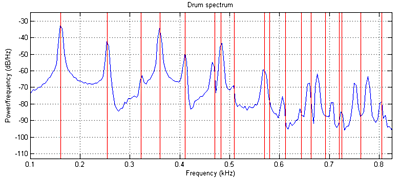sqrt(m+n) where m,n=1,2,3,...Where the first term (
sqrt(2)) corresponds to the fundamental mode of the drum.The first few modes are
sqrt(2), sqrt(5), 2*sqrt(2), sqrt(10), sqrt(13), sqrt(17), sqrt3*sqrt(2).
For this exercise, you will simulate the 2D wave equation on a square mesh in realtime to produce drum-like sounds.
This year we will add a nonlinear effect related to the intantaneous tension in the mesh.
Procedure:
Read Study Notes on Numerical Solutions of the Wave Equation with the Finite Difference Method. The main result you will need to simulate is equation 2.18. A matlab program gives a sequential version of the algorithm and plots the Fourier modes of the drum. Another version is tuned to middle C (261 Hz). You can see in the figure below that the simulated sound spectrum (blue) matches the theoretical drum modes (red) up to about mode 8 or 9 (see Physical modeling with a 2D waveguide mesh for details) . The theoretical square drum mode frequencies follow the ratio sequence:
sqrt(m+n) where m,n=1,2,3,...
Where the first term (sqrt(2)) corresponds to the fundamental mode of the drum.
The first few modes are sqrt(2), sqrt(5), 2*sqrt(2), sqrt(10), sqrt(13), sqrt(17), sqrt3*sqrt(2).

Modifying the boundary conditions, damping, wave speed, drum size, and distrubution of input energy can modifiy the sound of the simulation from drum-like, to chime-like, to gong-like or bell-like. You can modify the program further to include frequency-dependent damping and other effects. This version simluates a long, thin bar struck at one end.
Adding tension modulation allows pitch bending observed in a real drum after a large amplitude input. The large amplitude means that the membrane is stretched more, and therefore the speed of propagation (and therefore pitch) is increased. This matlab code produces an exagerated pitch effect with initial high amplitude.
You will probably want to read
for ideas on parallelization. Also read documentation on incrementail compilation. Some compile times may be very long.
You may want to read the Evans and Sutherland HDL guide, chapter 9, for info on using generate statement.
The hardware audio interface is a Wolfson WM8731 codec which is controlled by an I2C interface. I have simplified the drivers somewhat. The cleanest version is in this project zip. The context for the drivers is explained in the DSP page, example 1. The audio codec produces (and outputs) 16-bit 2's complement numbers. The 16-bit numbers should be considered as fractional values in the range +1 to -1 volt. This example (courtesy of Scott McKenzie and Miles Pedrone) outputs a square wave from the audio port. The first example on the DE2 hardware page shows how to hook up a DDS example.
Student examples running on FPGA:
10*(number of wave equation nodes)*(audio sample frequency) . 1000x44000=44x106 operations/second. For a more accurate 20x20 grid you will need ~200x106
operations/sec. Clearly some parallel processing will be necessary.
Be prepared to demo your design to your TA in lab.
Your written lab report should include the sections mentioned in the policy page, and :